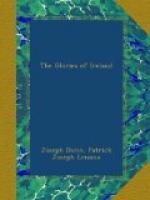All the Indo-European languages are more or less related to one another. We Irish must acknowledge a relationship, or rather a very distant connecting tie, with English. But, to trace this home, Irish must be followed back to the very oldest form of its words, and English must be followed back to Anglo-Saxon and when possible to Gothic. The hard mutes (p, t, c) of Celtic (and, for that matter, of Sanscrit, Zend, Greek, Latin, Slavonic, and Lithuanian) will be represented in Gothic by the corresponding soft mutes (b, d, g), and the soft mutes in Celtic by the corresponding, hard mutes in Gothic. Thus we find the Irish dia (god) in the Anglo-Saxon tiw, the god of war, whose name is perpetuated for all time in Tiwes-daeg, now “Tuesday”, and we find the Irish dead in the Anglo-Saxon “toth”, now “tooth”, and so on. But of all the Indo-European languages Old Irish possesses by far the nearest affinity to Latin, and this is shown in a great many ways, not in the vocabulary merely, but in the grammar, which for philologists is of far more importance,—as, for example, the b-future, the passive in-r, the genitive singular and nominative plural of “o stems”, etc. Thus the Old Irish for “man”, nom. fer, gen. fir, dat. fiur, acc. fer n—, plur. nom. fir, gen. fer n—, is derived from the older forms viros, viri, viro, viron, nom. plur. viri, gen. plur. viron, which everyone who knows Latin can see at a glance correspond very closely to the Latin inflections, vir, viri, viro, virum, nom. plur. viri, etc.
So much for the language. When did this language begin to be used in literature? This question depends upon another—When did the Irish begin to have a knowledge of letters; when did they begin to commit their literature to writing; and whence did they borrow their knowledge of this art?
The oldest alphabet used in Ireland of which remains exist appears to have been the Ogam, which is found in numbers of stone inscriptions dating from about the third century of our era on. About 300 such inscriptions have already been found, most of them in the southwest of Ireland, but some also in Scotland and Wales, and even in Devon and Cornwall. Wherever the Irish Gael planted a colony, he seems to have brought his Ogam writing with him.
The Irishman who first invented the Ogam character was probably a pagan who obtained a knowledge of Roman letters. He brought back to Ireland his invention, or, as is most likely, invented it on Irish soil. Indeed, the fact that no certain trace of Ogam writing has been found upon the European continent indicates that the alphabet was invented in Ireland itself. An inscription at Killeen Cormac, Co. Kildare, survives which seems to show that the Roman alphabet was known in Ireland in pagan times. Ogam is an alphabet suitable enough for chiselling upon stones, but too cumbrous for the purposes of literature.




